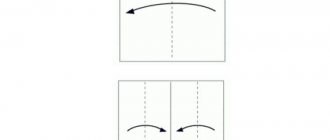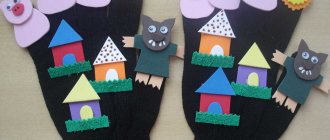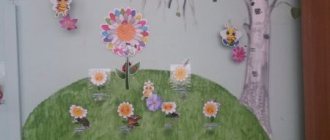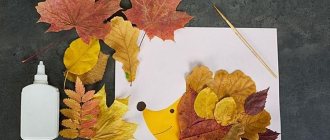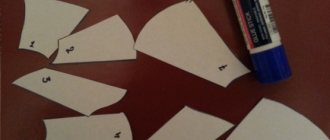Summary of a lesson on designing from natural materials in kindergarten. Senior group
Summary of GCD for the senior group on designing from natural material “Goldfish”
Description of the material: I offer you a summary of GCD for children of the senior group on designing from natural material “Goldfish” Purpose: to make crafts from natural material; enriching knowledge about the variety of natural materials and its use in crafts. Objectives: 1. To consolidate the idea of aquarium fish. 2. Foster an aesthetic attitude towards nature. 3. Continue to introduce children to the properties of natural materials. 4. Enrich children's vocabulary with verbs, nouns, adjectives and develop children's imagination. 6. Compose variants of images (fish)
from several parts 7. Develop children’s abilities in team work.
Visual material: Illustrations of an aquarium with fish. Handouts: shells, corrugated paper, plasticine, scissors, confetti.
Progress of the lesson
Children stand in a semicircle on the carpet.
Educator: Listen (the sound of the sea sounds)
.
Let's imagine that we are on the seashore. We have a blue sky above our heads, a bright sun shining, golden sand under our feet, and the sea ahead. Now I will tell you an interesting story. A wide variety of fish live in the sea. There are fish that are edible for humans. Fishermen catch them, and we buy them, cook them and eat them. These are flounder, mackerel, herring. (I invite the children to look at the fish)
There are poisonous fish.
And there are aquarium fish, they live at home in an aquarium. We made an aquarium, but so far no one lives in it. And today we will make fish for our aquarium. What parts does a fish consist of? (children's answers)
.
All fish have a tail. He serves as their rudder. Fish also have fins. Why do you think fish need fins? (to swim)
.
Of course, fish have eyes. What are eyes for? (see)
.
The body of the fish is covered with plates - these are scales. Why does the fish need it? (defend)
.
Now we'll swim a little. Physical education minute. We are now sailing on the sea And frolicking in the open space (rowing forward)
Have fun catching up with the dolphin
(raise your arms - wave-like movements)
And now it’s time to dive Into the underwater world.
(squat down and head to the right and left) Educator: And now we will sit at the tables. Please note that on your table there are: shells, from two shells we will make the body of a fish, from a strip of corrugated paper we will make a tail, from confetti we will make eyes. Educator. Now I will show you how you can make a very beautiful fish (I show a fish from shells) (I show how a fish is made.)
We take two shells, this will be the body of the fish, and using plasticine we connect the two halves of the shell.
Then we take scissors and a strip of corrugated paper and use it as “grass”. We twist the cut strip and use plasticine to attach the tail of the fish. Glue the fish's eyes. Let's get started. Then the teacher attaches a fishing line to each fish and hangs the fish in our aquarium. Educator: Look what beautiful fish are in our aquarium, and now they will live in our group. (children look at the fish and share their impressions)
.
We recommend watching:
Summary of educational activities in the senior group “Journey to a Fairy Tale” Summary of a mathematics lesson for children of the senior orthopedic group Summary of educational and gaming activities in the senior group in the section of the “Childhood” program Synopsis of educational activities for the perception of music in the senior group of kindergarten
Similar articles:
Lesson in the senior group of kindergarten on the topic of February 23
Lesson notes for children of senior preschool age. Topic: Invisible air
Summary of organized educational activities for children of the senior group
Notes for mathematics classes in the senior group
Lesson summary on the topic “Reserve” in the senior group
Artistic design from natural materials in kindergarten
A variety of natural materials are widely used in the constructive activities of preschool children. The main task of the teacher is to teach to feel the specificity of natural material, to see the diversity of its colors, shapes, textures and on this basis to create a variety of artistic images.
The implementation of tasks, on the one hand, develops imagination and creativity, on the other hand, leads children to master a generalized method of constructing an image based on clarity.
In studies of the development of considerations in preschool children, O. M. Dyachenko identifies two main qualitatively different methods of action for constructing an imaginary image:
1) “objectification”, when a child sees a certain object in an unfinished drawing;
2) “inclusion”, when the figure specified in the drawing turns into a secondary element of the imaginary image.
For the development of creative imagination it is fundamentally important:
- develop in children the ability to analyze material, first as the basis of a future image created by the “objectification” method, then as a detail significant for constructing a holistic image using the “inclusion” method;
- to develop such design skills and techniques as “completing” the image, “changing the spatial position”, “removing unnecessary things”, “combining”.
Main tasks of the first stage of training
constructive skills in making crafts from natural materials:
- develop the ability to analyze natural material as the basis for a future craft (select roots, branches, twigs);
— teach three basic techniques for constructing an image using the “objectification” method: the ability to change the spatial arrangement, complete construction, and remove unnecessary things.
The “objectification” method is fundamental, since it allows you to develop the ability to see the whole before the parts.
1st-2nd lessons:
— consideration of natural material;
— highlighting various images in configurations;
— construction of two or three images on one basis.
3-4th lessons:
- tasks of a problematic nature are given: the task is to create crafts based on a given basis;
— new materials are offered: pieces of tree bark of different sizes and configurations, dry tree mushrooms (as a base).
5-6th lessons:
- design is carried out according to plan.
Having determined the idea, children independently select natural materials: large ones are used as the basis of the craft, small ones are used as details.
At the second stage
The following main tasks are solved:
- develop the ability to build an image using the “inclusion” method;
- analyze natural material not only as the basis of a future craft, but also as a detail significant for constructing a holistic image (the same material can be both the basis of a craft and its detail).
1st lesson: design according to your own plans from material collected during the excursion.
2nd lesson: design according to your own design from a certain natural material obtained as an element of a future craft;
3rd lesson: completing the construction of a figure based on cross-shaped sticks-twigs;
Lesson 4: completing a figure based on two connected acorns, alder cones on a branch, straw tied in a certain place, pieces of bark with a stick fixed in the center.
Main tasks of the third stage
:
— expand the basic ways and techniques of building an image;
- to develop the ability to implement a plan, taking into account the general plot, detailing and enriching the image, and the specifics of the natural material.
Learning to design according to your own plot is the main goal.
1st-2nd lessons:
- constructing an invented fairy tale or story based on the plot.
Artistic design from natural materials
Middle group
Main goals
- develop the ability to analyze natural materials as the basis for future crafts;
— teach three basic techniques for constructing an image using the “objectification” method: changing the spatial arrangement, completing construction, removing unnecessary things.
Technical skills of children
Fastening with plasticine; fastening with glue.
Teacher's help
Helps to break off and cut off excess parts; helps attach additional parts, deepen the gap (mouth, beak).
Material for work
Roots, branches, twigs, pieces of tree bark, dry tree mushrooms, small natural material.
Senior group
Main goals
- develop the ability to build an image using the “inclusion” method;
- to develop the ability to analyze natural material not only as the basis of a future craft, but also as a detail significant for constructing a holistic image, by including it in this integrity;
— expand the basic ways and techniques of building an image;
- develop the ability to implement a plan.
Technical skills of children
Fastening with plasticine; fastening with glue; fastening with colored thin wire.
Teacher's help
Working with an awl; working with a knife; varnishing
Material for work
Cones, acorns, chestnuts, shells, alder cones on a branch, straw, bark, small natural material.
Stages of introducing natural material
Stages of introducing natural material in the middle group:
1st stage
Type of material:
roots, branches, twigs, small natural material.
2nd stage
Type of material:
pieces of tree bark of various sizes and configurations, dry tree mushrooms, small natural material.
Method of action
“Objectification”: change in spatial arrangement; completion; removing excess.
Stages of introducing natural material in the senior group:
3rd stage
Type of material:
cones, acorns, chestnuts, shells, small natural material.
Method of action
“Inclusion”: the use of natural material not only as the basis for a future craft, but also as part of the whole; multifunctional use.
4th stage
Type of material
: two sticks-twigs, fastened in the middle.
Method of action
Completing the figure.
5th stage
Type of material: two connected acorns, alder cones on a branch, straw tied in a certain place, pieces of bark with a stick fixed in the center.
Method of action
Completing the figure.
6th stage
A variety of natural materials.
Method of action
Application of all methods.
Design in kindergarten: approximate long-term calendar planning / ed. T. A. Kruglenya. – 2nd ed. – Minsk: Zorny Verasok, 2022. – 67 pp., pp. 12-14.
Construction as a type of children's creativity
Definition 1
Construction is the process of constructing an object, bringing various parts, elements and objects into a certain relative position.
Construction is a type of children's activity during which the child constructs a specific object (according to a scheme, plan, spontaneously, etc.). Construction occurs by composing parts or elements (cubes, building material, natural material, waste material, etc.) in any order, depending on the type of construction.
Construction is of great importance in the development of a preschool child, in his mastery of various types of practical activities. By its nature, construction is a productive type of children's activity.
Are you an expert in this subject area? We invite you to become the author of the Directory Working Conditions
The main feature of design is that it is creative in nature, as it is aimed at obtaining a specific expected product. In addition, design is also defined as a special experimental research and search activity aimed at obtaining a total product consisting of individual elements. Also, a number of researchers consider design from a creative point of view.
In the design process, the child uses a variety of materials that have different characteristics (size, shape, tactile sensations, etc.). By constructing from various materials, the child learns to generalize, masters universal skills for constructing a single whole from a set of elements.
Definition 2
Creative design is a complex system of practical and mental actions aimed at solving a specific constructive problem.
Finished works on a similar topic
Course work Designing from natural materials as a means of developing children's creativity 450 ₽ Abstract Designing from natural materials as a means of developing children's creativity 240 ₽ Test work Designing from natural materials as a means of developing children's creativity 240 ₽
Receive completed work or specialist advice on your educational project Find out the cost
Creativity in construction consists in the fact that a child, while engaged in construction, carries out such processes as thinking and planning his upcoming activities, translating an incipient mental concept into a real creative product.
Note 1
Thus, children's creative construction has a comprehensive impact on the child's development. It promotes the formation of a variety of practical skills, as well as the development of speech, memory, thinking, imagination and fantasy of the child.
Types of children's design
Depending on what material is used for construction, its types are distinguished:
- Construction from building materials is a type of construction that uses specially created objects and elements (cubes, cylinders, prisms, bricks, Lego parts, etc.). When using a set of building materials for construction, the child can design both according to the scheme and according to his own ideas.
- Paper construction is a type of construction when paper is used as a material, from which children construct various figures, objects, etc. This type of design is also called origami.
- Construction from natural materials is a type of construction when pebbles, cones, acorns, leaves, stems, etc. are used as building materials. From natural materials, children, under the guidance of a teacher, construct various crafts and toys.
- Construction from waste material is a type of construction in which everything that seemed necessary to be thrown away, but can be used for creativity (capsules from chocolate eggs, baby food jars, cotton pads and sticks, etc.) is used as material.
Each type of design has its own characteristics. However, their fundamentals are the same - the child in his design reflects mainly real objects that have a certain practical significance.
MAGAZINE Preschooler.RF
“Applique from natural materials in kindergarten”Designing from natural materials is a creative and useful activity, during which children create original products, while improving their analytical abilities, showing imagination and talent as an inventor.
Children, in addition:
- study the properties of natural materials,
- learn to plan the sequence of their actions,
- learn to select material,
- learn to think through the best option for combining the details of a craft into a holistic image,
- learn to approach product design creatively.
The process of inventing and making such crafts is a source of joy and inspiration, enriches the child’s personality and contributes to its harmonious development, and also cultivates patience and determination.
Learning objectives for the senior group:
- Develop skills in thoughtfully selecting natural materials for constructing a future craft (for example, selecting pine cones, roots and twigs, leaves of the desired size and shape, etc.)
- Learn to see the holistic image of a craft and build it through “objectification” , using basic design techniques.
- To teach design according to plan, the ability to combine crafts into a single plot composition.
- Develop curiosity and creative thinking.
Preparatory group:
- Consolidating and improving the skill of designing according to one’s own design, taking into account the characteristics of the material, the general plot and detail.
- Modeling a holistic image using the “inclusion” , when a child analyzes natural material and learns to see in it not only the basis (for example, the body of a bear cub), but also an additional important detail, for example, a bell or a basket.
Types of crafts by technique:
- Construction is the creation of three-dimensional crafts by combining individual fragments and elements into a holistic image.
Types of design and application from natural materials:
Object design - a single three-dimensional figure or applique (butterfly, flower, donkey, cat, gnome, etc.).
Story composition ( “At the Zoo” , “Forest School” , “Princess Birthday” , etc.) - children work in subgroups or collectively, compose and tell fairy tales, give verbal characteristics to their characters, create living images (the good turtle , a playful bunny, an important elephant), make up a single composition from individual figures based on an independently invented plot or “revival” of the heroes of your favorite fairy tales and cartoons.
Creation of large compositions on the territory of the kindergarten: planar (a carpet of leaves, sticks, pebbles, shells), as well as volumetric (a medieval city with a castle and houses, surrounded by a fortress, drawbridges and ditches, or a cosmodrome with rockets and robots). This is a group work that takes up to several weeks.
Craft modeling techniques:
- change of location in space - the child carefully examines the material, imagines what figure the natural configuration resembles, turns the roots and branches in different directions;
- the method of “completing” the image - the child fixes the material on a stand in a certain spatial position and complements the original image with the help of parts from another natural material or plasticine, creating, for example, a figurine of a hedgehog, dog, princess or acrobat;
- combination method - creating plot compositions from several figures;
- a way to “remove the excess” - the child breaks off the extra branches, and then adds the necessary details, for example, a head, and gets the image of a clown.
Material is usually collected on a summer or autumn day in a park, garden, forest, summer cottage, field - during a family vacation, pleasant walks or exciting excursions. It is worth remembering that the texture and shape of unripe berries and seeds changes when dried.
Nature generously gives us rich material for creativity. You just have to turn on your imagination - and ordinary chestnuts, bizarrely shaped branches and roots, fluffy cones will turn into amazing fairy-tale people or be transformed into an original interior decoration. Classes on making crafts from natural materials in kindergarten not only develop fine motor skills, analytical thinking, sensory skills and train the eye, but also give every child a sea of positive emotions and the joy of contact with the world of beauty.
| Next > |
